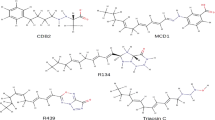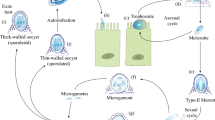Abstract
Computational approaches to predict structure/function and other biological characteristics of proteins are becoming more common in comparison to the traditional methods in drug discovery. Cryptosporidiosis is a major zoonotic diarrheal disease particularly in children, which is caused primarily by Cryptosporidium hominis and Cryptosporidium parvum. Currently, there are no vaccines for cryptosporidiosis and recommended drugs are ineffective. With the availability of complete genome sequence of C. hominis, new targets have been recognized for the development of effective and better drugs and/or vaccines. We identified a unique hypothetical protein (TU502HP) in the C. hominis genome from the CryptoDB database. A three-dimensional model of the protein was generated using the Iterative Threading ASSEmbly Refinement server through an iterative threading method. Functional annotation and phylogenetic study of TU502HP protein revealed similarity with human transportin 3. The model is further subjected to a virtual screening study form the ZINC database compound library using the Dock Blaster server. A docking study through AutoDock software reported N-(3-chlorobenzyl)ethane-1,2-diamine as the best inhibitor in terms of docking score and binding energy. The reliability of the binding mode of the inhibitor is confirmed by a complex molecular dynamics simulation study using GROMACS software for 10 ns in the water environment. Furthermore, antigenic determinants of the protein were determined with the help of DNASTAR software. Our findings report a great potential in order to provide insights in the development of new drug(s) or vaccine(s) for treatment and prophylaxis of cryptosporidiosis among humans and animals.








Similar content being viewed by others
References
Abubakar I, Aliyu SH, Arumugam C, Usman NK, Hunter PR (2007) Treatment of cryptosporidiosis in immunocompromised individuals: systematic review and meta-analysis. Br J Clin Pharmacol 63:387–393. doi:10.1111/j.1365-2125.2007.02873.x
Adams MA, Suits MD, Zheng J, Jia Z (2007) Piecing together the structure–function puzzle: experiences in structure based functional annotation of hypothetical proteins. Proteomics 7:2920–2932. doi:10.1002/pmic.200700099
Altschul SF, Madden TL, Schaffer AA, Zhang J, Zhang Z, Miller W, Lipman DJ (1997) Gapped BLAST and PSI BLAST: a new generation protein database search programs. Nucleic Acids Res 25:3389–3402
Baker D (2006) Prediction and design of macromolecular structures and interactions. Philosophical Transactions of the Royal Society of London B: Biological Sciences 361:459–463
Berahmat R, Spotin A, Ahmadpour E, Mahami-Oskouei M, Rezamand A, Aminisani N, Ghojazadeh M, Ghoyounchi R, Mikaeili-Galeh T (2017) Human cryptosporidiosis in Iran: a systematic review and meta-analysis. Parasitol Res 116(4):1111–1128. doi:10.1007/s00436-017-5376-3
Berendsen HJ, van der Spoel D, van Drunen R (1995) GROMACS: a message-passing parallel molecular dynamics implementation. Comput Phys Commun 91:43–56. doi:10.1016/0010-4655(95)00042-E
Bernstein FC, Koetzle TF, Williams GJ Jr, Meyer EF, Brice MD, Rodgers JR, Kennard O, Shimanouchi T, Tasumi M (1977) The Protein Data Bank. A computer-based archival file for macromolecular structures. Eur J Biochem 80:319–324. doi:10.1111/j.1432-1033.1977.tb11885.x
Bhasin M, Raghava GPS (2004) Prediction of CTL epitopes using QM, SVM and ANN techniques. Vaccine 22:3195–3204. doi:10.1016/j.vaccine.2004.02.005
Burland TG (1999) DNASTAR’s Lasergene sequence analysis software. Methods Mol Biol 132:71–91. doi:10.1385/1-59259-192-2:71
Chang TH, Wu LC, Lee TY, Chen SP, Huang HD, Horng JT (2013) EuLoc: a webserver for accurately predict protein subcellular localization in eukaryotes by incorporating various features of sequence segments into the general form of Chou’s PseAAC. J Comput Aided Mol Des 27(1):91–103
Chen J, Liu H, Yang J, Chou KC (2007) Prediction of linear B-cell epitopes using amino acid pair antigenicity scale. Amino Acids 33:423–428. doi:10.1007/s00726-006-0485-9
Colovos C, Yeates TO (1993) Verification of protein structures: patterns of nonbonded atomic interactions. Protein Sci 9:1511–1519
Efstratiou A, Ongerth JE, Karanis P (2017) Waterborne transmission of protozoan parasites: review of worldwide outbreaks—an update 2011–2016. Water Res 114:14–22. doi:10.1016/j.watres.2017.01.036
Eisenberg D, Lüthy R, Bowie JU (1997) VERIFY3D: assessment of protein models with three dimensional profiles. Methods Enzymol 277:396–404
Gasteiger E, Hoogland C, Gattiker A, Duvaud S, Wilkins MR, Appel RD, Bairoch A, (2005) Protein identification and analysis tools on the ExPASy server. In: John M. Walker (ed) Proteomics Protoc Handb, Humana Press, Totowa p 571–607. doi:10.1385/1-59259-890-0:571
Guerrant DI, Moore SR, Lima AA, Patrick PD, Schorling JB, Guerrant RL (1999) Association of early childhood diarrhea and cryptosporidiosis with impaired physical fitness and cognitive function four-seven years later in a poor urban community in northeast Brazil. AmJTrop Med Hyg 61:707–713
Heiges M, Wang H, Robinson E, Aurrecoechea C, Gao X, Kaluskar N, Rhodes P, Wang S, He CZ, Su Y, Miller J, Kraemer E, Kissinger JC (2006) CryptoDB: a Cryptosporidium bioinformatics resource update. Nucleic Acids Res 34:D419–D422. doi:10.1093/nar/gkj078
Hess B, Bekker H, Berendsen HJ, Fraaije JG (1997) LINCS: a linear constraint solver for molecular simulations. J Comput Chem 18:1463–1472
Ilyas M, Rahman Z, Shamas S, Alam M, Israr M, Masood K (2011) Bioinformatics analysis of envelope glycoprotein E epitopes of dengue virus type 3. African J Biotechnol 10(18):3528–3533
Irwin JJ, Shoichet BK (2005) ZINC—a free database of commercially available compounds for virtual screening. J Chem Inf Model 45:177–182. doi:10.1021/ci049714+
Laskowski RA, MacArthur MN, Moss DS, Thorton JM (1993) PROCHECK-a program to check the steriochemical quality of protein structures. J Appl Crystallogr 26:283–291
Lipinski CA, Lombardo F, Dominy BW, Feeney PJ (2001) Experimental and computational apparoaches to estimate solubilitty and permeability in drug discovery and development settings. Adv Drug Deliv Rev 46:3–26. doi:10.1016/S0169-409X(96)00423-1
Lorber D M, Shoichet BK (1998) Flexible ligand docking using conformational ensembles. Protein Sci 7:938–950
Maertens GN, Cook NJ, Wang W, Hare S, Gupta SS, Oztop I, Lee K, Pye VE, Cosnefroy O, Snijders AP, Kewalramani VN, Fassati A, Engelman A, Cherepanov P (2014) Structural basis for nuclear import of splicing factors by human transportin 3. Proc Natl Acad Sci U S A 111:2728–2733. doi:10.1073/pnas.1320755111
Mahon M, Doyle S (2017) Waterborne outbreak of cryptosporidiosis in the South East of Ireland: weighing up the evidence. Ir J Med Sci 1–6. doi: 10.1007/s11845-016-1552-1
Malleshappa Gowder S, Chatterjee J, Chaudhuri T, Paul K (2014) Prediction and analysis of surface hydrophobic residues in tertiary structure of proteins. Scientific World Journal. doi:10.1155/2014/971258
Morris GM, Ruth H, Lindstrom W, Sanner MF, Belew RK, Goodsell DS, Olson AJ (2009) Software news and updates AutoDock4 and AutoDockTools4: automated docking with selective receptor flexibility. J Comput Chem 30:2785–2791. doi:10.1002/jcc.21256
Pain A, Crossman L, Parkhill J (2005) Comparative apicomplexan genomics. Nat Rev Microbiol 3:454–455. doi:10.1080/10409238.2017.1290043
Pierleoni A, Martelli PL, Fariselli P, Casadio R (2006) BaCelLo: a balanced subcellular localization predictor. Bioinformatics 22(14):e408–e416
Plewczynski D, Pas J, Von Grotthuss M, Rychlewski L (2004) Comparison of proteins based on segments structural similarity. Acta Biochim Pol 51:161–172
Rider SD, Zhu G (2010) Cryptosporidium: genomic and biochemical features. Exp Parasitol 124:2–9. doi:10.1016/j.exppara.2008.12.014
Saitou N, Nei M (1987) The neighbour-joining method: a new method for reconstructing phylogenetic tree. Mol Bio Evol 4(4):406–425
Saha S, Raghava GPS (2004) BcePred: prediction of continuous B-cell epitopes in antigenic sequences using physico-chemical properties. Artif Immune Syst Third Int Conf 3239:197–204. doi:10.1007/978-3-540-30220-9_16
Schrödinger, LLC (2010) The PyMOL molecular graphics system, version 1.3r1. Schrödinger, LLC, Portland, Oregon
SchuÈttelkopf AW, Van Aalten DM (2004) PRODRG: a tool for high-throughput crystallography of protein–ligand complexes. Acta Crystallogr D Biol Crystallogr 60(8):1355–1363
Scott WRP, Hunenberger PH, Tironi IG et al (1999) The GROMOS bimolecular simulation program package. J Phys Chem A 103(19):3596–3607
Sharling L, Liu X, Gollapalli DR, Maurya SK, Hedstrom L, Striepen B (2010) A screening pipeline for antiparasitic agents targeting Cryptosporidium inosine monophosphate dehydrogenase. PLoS Negl Trop Dis 4(8):e794. doi:10.1371/journal.pntd.0000794
Snelling WJ, Xiao L, Ortega-Pierres G, Lowery CJ, Moore JE, Rao JR, Smyth S, Millar BC, Rooney PJ, Matsuda M, Kenny F, Xu J, Dooley JSG (2007) Cryptosporidiosis in developing countries. J Infect Dev Ctries 1:242–256. doi:10.3855/jidc.360
Striepen B (2013) Time to tackle cryptosporidiosis. Nature 503:189–191
Tambunan US, Parikesit AA (2009) In silico analysis of envelope dengue virus-2 and envelope dengue virus-3 protein as the backbone of dengue virus tetravalent vaccine by using homology modeling method. Online J Biol Sci 9:6–16
Tamura K, Stecher G, Peterson D, Filipski A, Kumar S (2013) MEGA6: molecular evolutionary genetics analysis version 6.0. Mol Biol Evol 30(12):2725–2729
Vaught A (1996) Graphing with Gnuplot and Xmgr: two graphing packages available under linux. Linux Journal 28es:7
Watson JD, Laskowski RA, Thornton JM (2005) Predicting protein function from sequence and structural data. Curr Opin Struct Biol 5:275–284. doi:10.1016/j.sbi.2005.04.003
Wiederstein M, Sippl MJ (2007) ProSA-Web: interactive Web service for the recognition of errors in three-dimensional structures of proteins. Nucleic Acids Res 35:W407–W410. doi:10.1093/nar/gkm290
Xu P, Widmer G, Wang Y, Ozaki LS, Alves JM, Serrano MG, Puiu D, Manque P, Akiyoshi D, Mackey AJ, Pearson WR, Dear PH, Bankier AT, Peterson DL, Abrahamsen MS, Kapur V, Tzipori S, Buck GA (2004) The genome of Cryptosporidium hominis. Nature 431:1107–1112
Yang J, Zhang Y (2015) Protein structure and function prediction using I-TASSER. Curr Protoc Bioinformatics 52:5–8. doi:10.1002/0471250953.bi0508s52
Yoder JS, Beach MJ (2010) Cryptosporidium surveillance and risk factors in the United States. Exp Parasitol 124:31–39. doi:10.1016/j.exppara.2009.09.020
Yu CS, Chen YC, Lu CH, Hwang JK (2006) Prediction of protein subcellular localization. Proteins 64:643–651. doi:10.1002/prot.21018
Acknowledgements
The authors duly acknowledge Prof. Mrutyunjay Suar, Director of School of Biotechnology, KIIT University, Bhubaneswar, for the institutional support. Especially, we are thankful to the bioinformatics facility of the school for the software and computing resources used in this study. The help from Ms. Subhashree Rout, PhD scholar, Bioinformatics Lab, is also of great importance particularly during the docking and MD simulation analysis. The kind help from Prof. Gagandeep Kang, Christian Medical College, Vellore (India), is greatly acknowledged.
Author information
Authors and Affiliations
Corresponding authors
Ethics declarations
Conflict of interest
The authors declare that they have no conflict of interest.
Electronic supplementary material
Supplementary Figure 1
(DOCX 260 kb)
Supplementary Table 1
(DOCX 284 kb)
Supplementary Table 2
(DOCX 15 kb)
Supplementary Table 3
(DOCX 85 kb)
Supplementary Table 4
(DOCX 81 kb)
Rights and permissions
About this article
Cite this article
Shrivastava, A.K., Kumar, S., Sahu, P.S. et al. In silico identification and validation of a novel hypothetical protein in Cryptosporidium hominis and virtual screening of inhibitors as therapeutics. Parasitol Res 116, 1533–1544 (2017). https://doi.org/10.1007/s00436-017-5430-1
Received:
Accepted:
Published:
Issue Date:
DOI: https://doi.org/10.1007/s00436-017-5430-1




